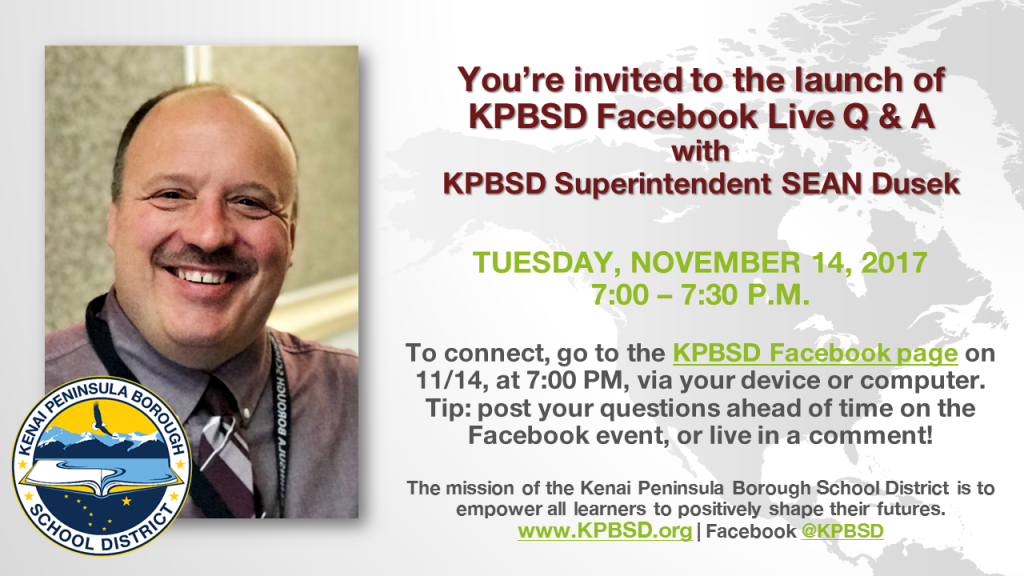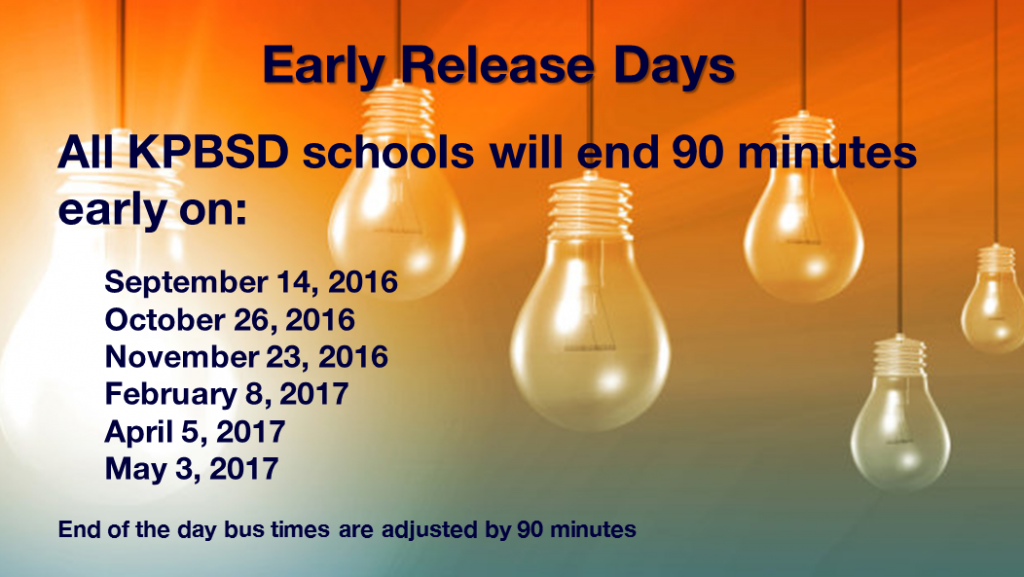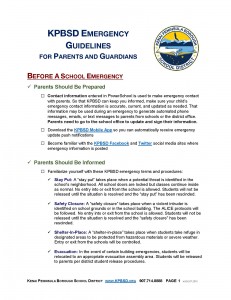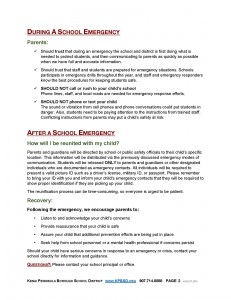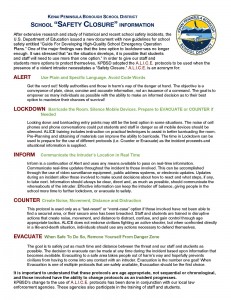Category: Communications
Tuesday: KPBSD Facebook LIVE Q and A with Superintendent Dusek
You’re invited to the launch of KPBSD
Facebook LIVE Q & A
with KPBSD Superintendent Sean Dusek
Tuesday, November 14, 2017
7:00 – 7:30 p.m.
How-to watch:
It’s simple. Go to the KPBSD Facebook page on 11/14/17, at 7:00 PM, via your device or computer, and connect! You’ll see that KPBSD is live – click to view.
How-to ask questions or share thoughts:
Post your questions ahead of time on the Facebook event page, or live during the event in a comment on the live video.
How Facebook LIVE Q&A works:
- KPBSD launches Facebook LIVE video, viewers click to view, and see content live in real time.
- Viewers type comments into the feed below the video.
- KPBSD does not “see” viewers via videoconferencing, this is a one way video view feed from KPBSD. Interaction happens via comments and post likes or emojis.
Everyone is invited to tune in – KPBSD parents and students, staff, community members, KPBSD partners, and KPBSD Key Communicators. Afterwards, the Q&A will be saved as a video to review at your convenience.
Why?
This Facebook live event is the first in a series to expand the KPBSD Key Communicator program, engaging our people and publics with conversation, and offering accurate stories, information, and responses to questions about the KPBSD. Please join in, and offer your thoughts and ideas.
Tip:
You don’t need a Facebook account to watch live.
- At 7:00 PM, go to https://www.facebook.com/livemap. Locate the live event streaming from Soldotna, Alaska, using the interactive map.
- Click the blue dot indicating Facebook LIVE is happening in Soldotna, and the video will pop up.
- Click on the video image to enlarge it on your screen. https://www.facebook.com/livemap
- note: You cannot post questions without a Facebook account. You can email them to communications@KPBSD.org, and we will answer as many as we can during the video LIVE Q&A.
The mission of the Kenai Peninsula Borough School District is to empower all learners to positively shape their futures.
www.KPBSD.org
Facebook Kenai Peninsula Borough School District
Questions?
Contact Pegge Erkeneff, KPBSD Communications Liaison, communications@KPBSD.org. Or private message Kenai Peninsula Borough School District on Facebook.
Parent Survey: Do student early release days make a difference?
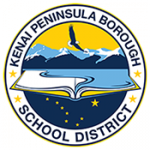 Please take a brief survey for parents open February 22 – March 11, 2017, to share your perceptions and thoughts about the six early release days for students.
Please take a brief survey for parents open February 22 – March 11, 2017, to share your perceptions and thoughts about the six early release days for students.
KPBSD staff is also completing a similar survey.
“Each school day, more than 1,200 KPBSD employees do all that they can to provide a quality education to our district’s students. A part of this work is our continuous improvement process that requires us to regularly evaluate our practices so that we can in turn, make the necessary changes to help our students’ find success. An intricate piece of our improvements is our professional development for our certified staff.
With the need to do more for our staff in this area, for the past four school years we designated six school days as minimum days–with a 90 minute early release for students, while staff works a maximum day in order to deliberately devote time to collaborate and collectively address the learning needs of our students.
Now that you are familiar with these shortened student school days, we want to receive your feedback. Please complete these questions, and provide your optional comments.” – Sean Dusek, superintendent
Link: Take the survey now
http://bit.ly/2017KPBSDEarlyReleaseSurveyPARENTS
Thank you very much for your time.
The next early release date is April 5, 2017
Links
- PARENT SURVEY: open through March 28, 2016
- information: KPBSD Early Release Days
KPBSD Key Communicator Collaboration
On February 7, 2017, a KPBSD Key Communicator Collaboration with more than seventy participants met at the Challenger Learning Center, in Kenai, Alaska.
Click here to view Key Communicators Collaboration presentation

Attendees: School board members, Key Communicators, site council representatives, leadership team, students, regional principals, community partners
Purpose: Collaborate with key people in our schools to talk about issues KPBSD faces this year, reflect on what we are doing well, ask questions, give administration a perspective, and grow advocates for KPBSD public education
KPBSD Key Communicators
KPBSD formed a network of people who are interested in our schools in order to cultivate positive relationships with the school district and in our diverse communities. Conversations happen every day in school parking lots, at the grocery store, via social media, and in everyday ordinary life interactions. At times, people of all ages who care about public education want facts about issues in order to communicate effectively with community leaders, each other, and elected officials. Our KPBSD Key Communicators are informed about school district initiatives, issues, and celebrations through responses to questions, email messages, media releases, and e-newsletters from district office communications–and have an open line of communication with district leadership to ask questions and express concerns and celebrations in the school district. Together we will broaden community advocates and share our #golden stories.
KPBSD Annual Report #golden #iAmKPBSD #innovation
Thirty two pages of stories and photos offer a glimpse into our diverse district. You’ve got options if you missed the print version:
flip through the online page turning version
view in a PDF format online
download it to your computer or device

Tip: When you see this icon, you can click it to read more story details online. #golden
The mission of the Kenai Peninsula Borough School District is to develop productive, responsible citizens who are prepared to be successful in a dynamic world.
Key Communicators connect to solve problems and learn issues
KPBSD Key Communicator Collaboration

Hosting a mix of eighty people, KPBSD facilitated five active hours at the Challenger Learning Center on Tuesday, February 2, 2016, following a school board worksession. School board members, high school students, KPBSD Key Communicators, school site council leaders, school principals, district leadership team members, and invited community members and business partners participated in the first Key Communicators Collaboration, an event designed to educate, gather input from the community, and grow advocacy for public education and KPBSD schools. At a time when the state fiscal climate is a top topic, KPBSD gathered a bunch of smart people together to brainstorm and face the challenges in the district, and to offer solutions.
A mix of presentations began in the morning with the State of the KPBSD—highlighting awards and accolades, innovation, funding, and legislation—and in the afternoon, identifying positive #golden stories in the schools and with KPBSD graduates. The interactive day concluded with tips about how to communicate collaboratively, with each person choosing one action they could take during this legislative session that was unique to their own personality, care and concern, and talent.
“I was very pleased that so many of the key communicators were able to attend our meeting that really strengthened our communication lines with stakeholders,” said Sean Dusek, superintendent. “The energy in the room was positive all day and I am looking forward to continued engagement with all of our stakeholders to help our schools improve how they meet the needs of our students.” With people from Seward, Seldovia, Sterling, Homer, Ninilchik, Nikiski, Kenai and Soldotna, and all areas in between, excellent perspective and common themes emerged. The feedback from everyone was, “let’s do this more often,” and “thank you for helping me understand the real issues that the district is addressing.” “A focus on the positive stories in coming months that happen every day is critical, and we need help from everyone to share these stories,” said Pegge Erkeneff, one of the presenters and organizers of the day. “Our Key Communicator network was started two years ago, and is growing. Conversations happen every day—in school parking lots, the grocery store, and with our elected officials. This started as a two-way exchange between the school district and people that each school principal identified in their school community. Now it is expanding to include students, and community partners. It’s a fantastic opportunity to hear from people who care about our schools, and also to share issues the district is facing. We look forward to a continued conversation, and interaction.”
- To learn more about KPBSD Key Communicators, visit the webpage, http://bit.ly/KeyCommunicators
- Links to the February 2, 2016, presentations are online at the KPBSD Communications blog: http://bit.ly/KPBSDCommunicationsBlog
- The Legislature and KPBSD webpage
- Read the KPBSD Highlight story
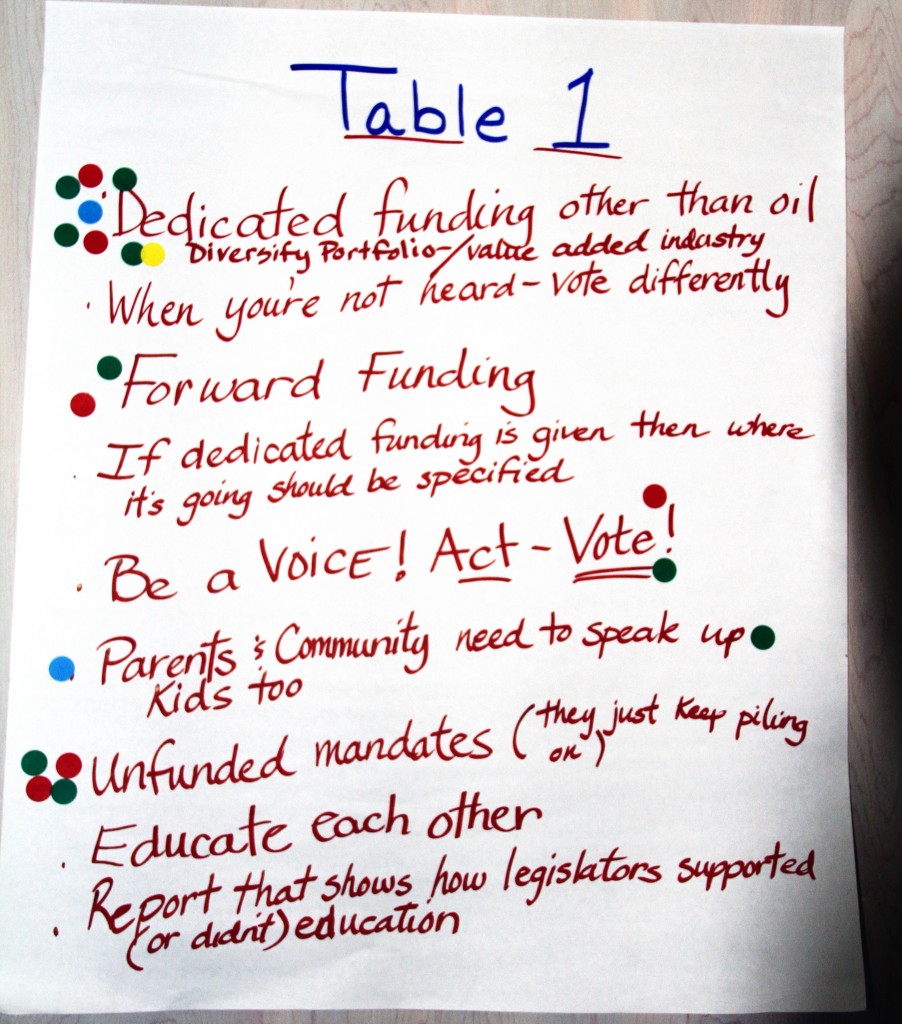
KPBSD Key Communicators Collaboration
 Key Communicators
Key Communicators
KPBSD formed a network of people who are interested in our schools in order to cultivate positive relationships with the school district and in our diverse communities. Conversations happen every day in school parking lots, at the grocery store, via social media, and in everyday ordinary life interactions. At times, people of all ages who care about public education want facts about issues in order to communicate effectively with community leaders, each other, and elected officials. The idea is that our Key Communicators will be informed about school district initiatives, issues, and celebrations through responses to questions, email messages, media releases, and e-newsletters from district office communications–and have an open line of communication with district leadership to ask questions and express concerns and celebrations in the school district. Together we will broaden community advocates and share our #golden stories.
On February 2, 2016, a KPBSD Key Communicator Collaboration with more than eighty participants took place from 10:00-3:00 p.m., at the Challenger Learning Center, in Kenai, Alaska.
Attendees: School board members, Key Communicators, site council representatives, leadership team, students, regional principals, community partners
Purpose: Collaborate with key people in our schools to talk about issues KPBSD faces this year, reflect on what we are doing well, ask questions, give administration a perspective, and grow advocates for KPBSD public education.
-
February 2, 2016: Midyear State of the KPBSD presentation
Key Communicator Collaboration, Challenger Center morning presentation, by Sean Dusek, superintendent; Dave Jones, assistant superintendent of instructional support; John O’Brien, assistant superintendent of instruction; Pegge Erkeneff, communications liaison
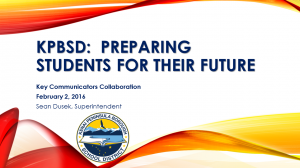
-
February 2, 2016: Communication: Make It Golden presentation
Key Communicator Collaboration, Challenger Center, afternoon presentation by Pegge Erkeneff, communications liaison
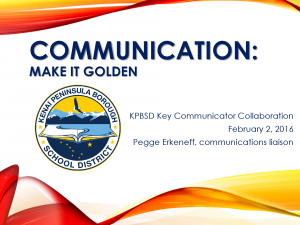
-
February 2, 2016: Collaboration and Communication closing presentation
Key Communicator Collaboration, Challenger Center, afternoon presentation by Pegge Erkeneff, communications liaison
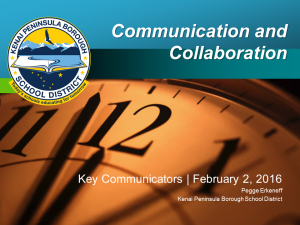
Links
KPBSD Key Communicators
KPBSD and The Legislature webpage
KPBSD Board of Education goals: Promote a shared value and responsibility for the process of education throughout the school district | Funding public education

KPBSD Key Communicators
People move in the direction of their conversations and seek accurate stories and information about the school district.
KPBSD Key Communicators help people in their local communities learn more about KPBSD, while also assisting the school district to learn and understand more about what people think, feel, and know. The concept is to promote a continuing exchange between Key Communicators and the school district, creating a loosely connected group of parents and citizens for two way communication.
People move in the direction of their conversations; KPBSD Key Communicators will be kept informed through email messages, media releases, and news from the KPBSD district office communications.

Opportunity
KPBSD formed a network of people who are interested in our schools in order to cultivate positive relationships with the school district and in our diverse communities. Conversations happen every day in school parking lots, at the grocery store, via social media, and so forth. The idea is that our Key Communicators will be kept informed about school district initiatives, issues and celebrations through email messages, media releases, and newsletters from district office communications. Together we will broaden community advocates and help share the golden stories that happen everyday in our schools and district.
Commitment
Key Communicators are asked to simply read the emails and information sent from KPBSD Communications, and potentially share any misconceptions, perceptions, or concerns they hear with KPBSD communications. If a particular issue arises, we may opt to ask you brief questions, utilize an area gathering, advocate or testify with legislators and community members depending on the topic, or broaden our understanding by directly contacting Key Communicators. Your name and contact information will not be published online anywhere as a contact for your school. Participation in Key Communicators is open, with no time frame limit. An annual survey will be conducted to determine shifts needed to grow positive and effective communications.
Meet and Greet
Key Communicators, district leadership, school board members, and any interested school staff are invited to gather informally for a meet and greet. This is an opportunity to meet face-to-face, connect, ask questions, and learn a bit more about things that are happening in the school district and with Key Communicators.
Three dates take place in September 2015, one each in the Central Peninsula, Seward area, and Southern Peninsula, with additional times throughout the 2015-2016 school year.
- Thursday, September 10, 2015, Seward Middle School library, 5:30-6:30 PM
- Tuesday, September 22, 2015, Soldotna High School library, 5:30-6:30 PM
- Monday, September 28, 2015, Homer Middle School library, 5:30-6:30 PM
Action
In early 2014, school principals nominated 2-3 people in their school community and provided Pegge Erkeneff, communication liaison, with the name, context, connection, or position in the community, and contact information including email, address, and telephone. Every year, principals and school board members offer additional names, and everyone interested in KPBSD schools are welcome to attend area gatherings.
If you are interested in becoming a KPBSD Key Communicator, please email Pegge Erkeneff, communications liaison, at Communications@kpbsd.org.

KPBSD Emergency Guidelines for Parents and Guardians
Before A School Emergency
Parents Should Be Prepared
Contact information entered in PowerSchool is used to make emergency contact with parents. So that KPBSD can keep you informed, make sure your child’s emergency contact information is accurate, current, and updated as needed. That information may be used during an emergency to generate automated phone messages, emails, or text messages to parents from schools or the district office. Parents need to go to the school office to update and sign their information.
- Download the KPBSD Mobile App so you can automatically receive emergency update push notifications
- Become familiar with the KPBSD Facebook and Twitter social media sites where emergency information is posted
Parents Should Be Informed
Familiarize yourself with these KPBSD emergency terms and procedures:
- Stay Put: A “stay put” takes place when a potential threat is identified in the school’s neighborhood. All school doors are locked but classes continue inside as normal. No entry into or exit from the school is allowed. Students will not be released until the situation is resolved and the “stay put” has been rescinded.
- Safety Closure: A “safety closure” takes place when a violent intruder is identified on school grounds or in the school building. The ALICE protocols will be followed. No entry into or exit from the school is allowed. Students will not be released until the situation is resolved and the “safety closure” has been rescinded.
- Shelter-In-Place: A “shelter-in-place” takes place when students take refuge in designated areas to be protected from hazardous materials or severe weather. Entry or exit from the schools will be controlled.
- Evacuation: In the event of certain building emergencies, students will be relocated to an appropriate evacuation assembly area. Students will be released to parents per district student release procedures.
During A School Emergency
Parents and Guardians
- Should trust that during an emergency the school and district is first doing what is needed to protect students, and then communicating to parents as quickly as possible when we have full and accurate information.
- Should trust that staff and students are prepared for emergency situations. Schools participate in emergency drills throughout the year, and staff and emergency responders know the best procedures for keeping students safe.
- SHOULD NOT call or rush to your child’s school
- Phone lines, staff, and local roads are needed for emergency response efforts.
- SHOULD NOT phone or text your child
- The sound or vibration from cell phones and phone conversations could put students in danger. Also, students need to be paying attention to the instructions from trained staff. Conflicting instructions from parents may put a child’s safety at risk.
After a School Emergency
How will I be reunited with my child?
Parents and guardians will be directed by school or public safety officials to their child’s specific location. This information will be distributed via the previously discussed emergency modes of communication. Students will be released ONLY to parents and guardians or other designated individuals who are documented as emergency contacts. All individuals will be required to present a valid picture ID such as a driver’s license, military ID, or passport. Please remember to bring your ID with you and inform your child’s emergency contacts that they will be required to show proper identification if they are picking up your child.
The reunification process can be time-consuming, so everyone is urged to be patient.
Recovery
Following an emergency, we encourage parents to:
- Listen to and acknowledge your child’s concerns
- Provide reassurance that your child is safe
- Assure your child that additional prevention efforts are being put in place
- Seek help from school personnel or a mental health professional if concerns persist
Should your child have serious concerns in response to an emergency or crisis, contact your school directly for information and guidance.
Questions?: Please contact your school principal or office.
KPBSD School “Safety Closure” information
KPBSD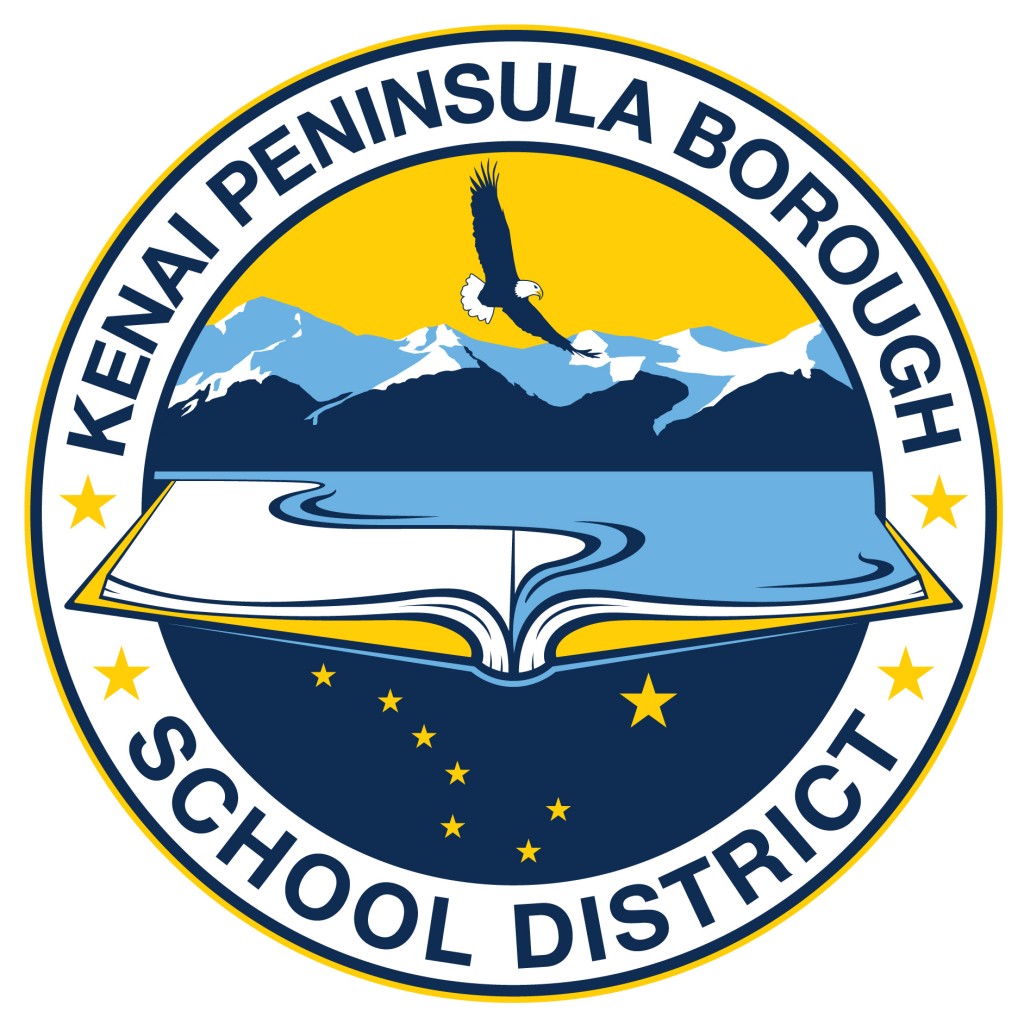
School “Safety Closure” information
After extensive research and study of historical and recent school safety incidents, the U.S. Department of Education issued a new document with new guidelines for school safety entitled “Guide For Developing High-Quality School Emergency Operation Plans.” One of the major findings was that the lone option to lockdown was no longer enough. It was stressed that “as the situation develops, it is possible that students and staff will need to use more than one option.” In order to give our staff and students more options to protect themselves, KPBSD adopted the ALICE protocols to be used when the presence of a violent intruder necessitates a “Safety Closure.” ALICE is an acronym for:
ALERT Use Plain and Specific Language. Avoid Code Words
Get the word out! Notify authorities and those in harm’s way of the danger at hand. The objective is a conveyance of plain, clear, concise and accurate information, not an issuance of a command. The goal is to empower as many individuals as possible with the ability to make an informed decision as to their best option to maximize their chances of survival!
LOCKDOWN Barricade the Room. Silence Mobile Devices. Prepare to EVACUATE or COUNTER if Needed
Locking down and barricading entry points may still be the best option in some situations. The noise of cell phones and phone conversations could put students and staff in danger so all mobile devices should be silenced. ALICE training includes instruction on practical techniques to assist in better barricading the room. Pre-Planning and obtaining of materials can improve the ability to barricade. The time in Lockdown can be used to prepare for the use of different protocols (i.e. Counter or Evacuate) as the incident proceeds and situational information is supplied.
INFORM Communicate the Intruder’s Location in Real Time
Inform is a continuation of Alert and uses any means available to pass on real-time information.
Communicate real-time updates throughout the incident to those involved. This can be accomplished through the use of video surveillance equipment, public address systems, or electronic updates. Updates during an incident allow those involved to make sound decisions about how to react and what steps, if any, to take next. Information should always be clear, direct and, as much as possible, should communicate the whereabouts of the intruder. Effective information can keep the intruder off balance, giving people in the school more time to further lockdown, or evacuate to safety.
COUNTER Create Noise, Movement, Distance and Distraction
This protocol is used only as a “last-resort” or “worst-case” option if those involved have not been able to find a secured area, or their secure area has been breached. Staff and students are trained in disruptive actions that create noise, movement, and distance to distract, confuse, and gain control through age appropriate tactics. ALICE does not endorse civilians fighting an active shooter, but when confronted directly in a life-and-death situation, individuals should use any actions necessary to defend themselves.
EVACUATE When Safe To Do So, Remove Yourself From Danger Zone
The goal is to safely put as much time and distance between the threat and our staff and students as possible. The decision to evacuate can be made at any time during the incident based upon information that becomes available. Evacuating to a safe area takes people out of harm’s way and hopefully prevents civilians from having to come into any contact with an intruder. Evacuation is the number one goal! When Evacuation is one of multiple protocols that are safely available, Evacuation should be the first choice.
It is important to understand that these protocols are age appropriate, not sequential or chronological, and those involved have the ability to change protocols as an incident progresses.
KPBSD’s change to the use of A.L.I.C.E. protocols has been done in conjunction with our local law enforcement agencies. These agencies also participate in the training of staff and students.

